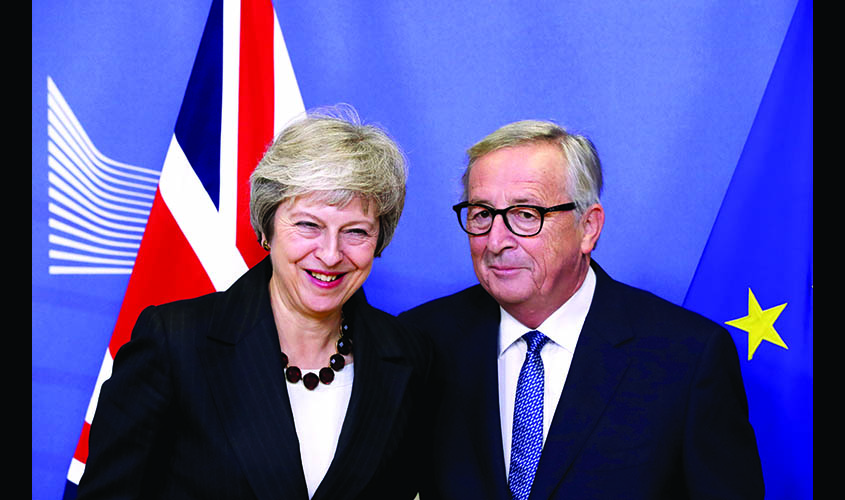UK Prime Minister says the alternative is ‘No Deal’ or ‘No Brexit’, although there are other alternatives being considered by the folks who reject the Withdrawal Agreement.
After a week fraught with tensions and threats, the European Council and British Prime Minister Theresa May have a mutually acceptable draft agreement for UK’s exit that has been recommended to the remaining 27 EU members and to the UK’s Parliament. This is in two parts: Part-I is “The Withdrawal Agreement (WA)”, which is legally binding, and Part-II is “The Political Declaration on the UK-EU Future Relationship (PDFR)”. The WA covers citizens’ rights, the financial cost of leaving and how to manage the Irish border, the presently indefinite transition period as well as judicial cooperation, intellectual property, procurement and administration procedures. The PDFR is separate as the EU Commission insisted the future relationship could only be legally negotiated once the UK was no longer a member state. At the moment the PDFR is nothing but a draft of intentions or so-called “aspirations”, for future argument.
Although this is being spun on both sides of the Channel as a victory, both Leavers and Remainers are dissatisfied with both parts of the “deal”. The Prime Minister says the alternative is “No Deal” or “No Brexit”, although there are other alternatives (preferably FTA as in Canada+++ or WTO) being considered by the folks who reject the WA. Some Conservative MPs say there is no stomach in the House of Common for “no deal”. Brexiteer MPs and the European Research Group appear to have delayed their challenge to the PM, now preferring to wait until after the Westminster vote; then they will know how Labour behaved and if the DUP did, in spite of their protestations and demonstrations this week, shore up the Prime Minister.
To many, it looks like the EU have called the shots and the Prime Minister has capitulated. The EU promised a spirit of co-operation but examination of the Draft does not bear witness to this. It was surprising to learn the Draft was written and printed in Brussels; the UK will still be under the interpretative arbitration of the ECJ, and have a single (EU) rule book, tax favouritism to former EU officials based in the UK and immunity to EU employees who may be discovered later as corrupt, too many UK committees with EU representatives to guarantee implementation. Professor Gwythian Prins, leading expert in strategic trends, claims the exclusion from EU security networks will “weaken our key security agreement, the Five Eyes Intelligence Alliance between the United Kingdom, the United States, Australia, Canada and New Zealand.” UK’s fishing industry feel that their rights will be compromised and surrendered to France in the New Fisheries Agreement, Scottish Tories and SNP MP’s both say the WA is unacceptable and does not take back control of UK’s coastal waters; Scotland feel they have been a bargaining chip in the negotiations with the EU. Spain are aggrieved they have no specified joint-say with UK about Gibraltar tariffs and immigration.
All this before the million-dollar border question of the “Northern Ireland Backstop”, which does not contain a unilateral exit clause, Martin Howe QC has renamed it “The whole UK permanent lock-in protocol with extra lock-in for Northern Ireland.” Sabine Weyand, Brussels Deputy Chief Negotiator, has told EU Ambassadors the backstop is not necessarily temporary, she said it could form the basis of a long term-permanent relationship. The Backstop has been denounced by some MPs as jeopardising the integrity of the United Kingdom.
The Irish border has also been accused of being a political gimmick, is the backstop actually necessary if there is agreement and the technologically streamlined “maximum facilitation” is adopted (as referred to by Theresa Villiers in The Sunday Guardian of 3 April 2016).
The Political Declaration session, in the House of Commons on Thursday, was a sales pitch by the Prime Minister. It descended into an inquisition about the WA from the Tory party and into a plea for the “People’s Vote” from Remainers, which the PM has absolutely ruled out. What happens next is the EU summit on Sunday, 25 November, followed by the Parliamentary vote in Westminster. As 50% of Conservative backbench MPs have publicly declared, they will vote against the WA, if/when the vote fails Labour could call a vote of no confidence in the Government or the Conservatives could, via 48 letters submitted to the 1922 Committee, call for a vote of no confidence in the Prime Minister. It still looks like a bumpy road to Brexit on 29 March 2019.
This weekend, Conservatives Boris Johnson and Philip Hammond, who are on opposing sides of the Brexit argument, are invited to speak on consecutive evenings at the DUP Party Conference in Belfast. The DUP has a confidence and supply arrangement with Theresa May, and has abstained twice this week on voting for amendments to the Finance Bill.
The Prime Minister (a Remainer, who is surrounded by Remainers in No.10) repeatedly says this WA reflects the result of the Referendum and this is what the British people want. In June 2016, 52% voted for Leave and 48% for Remain, and thus the WA has been deliberately designed as half-out and half-in the EU, neither one thing or the other and unacceptable to all.

